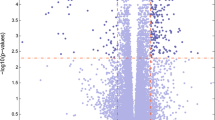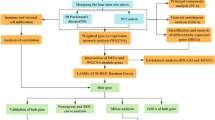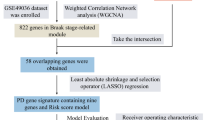Abstract
Parkinson’s disease (PD) is the second most common neurodegenerative disease that affects about 10 million people worldwide. Non-motor and motor symptoms usually accompany PD. Major depressive disorder (MDD) is one of the non-motor manifestations of PD it remains unrecognized and undertreated effectively. MDD in PD has complicated pathophysiologies and remains unclear. The study aimed to explore the candidate genes and molecular mechanisms of PD with MDD. PD (GSE6613) and MDD (GSE98793) gene expression profiles were downloaded from Gene Expression Omnibus (GEO). Above all, the data of the two datasets were standardized separately, and differentially expressed genes (DEGs) were obtained by using the Limma package of R. Take the intersection of the two differential genes and remove the genes with inconsistent expression trends. Subsequently, Gene Ontology (GO) and Kyoto Encyclopedia of Genes and Genomes (KEGG) analyses were investigated to explore the function of the common DEGs. Additionally, the construction of the protein–protein interaction (PPI) network was to search the hub genes, and then the least absolute shrinkage and selection operator (LASSO) regression was used to further identify the key genes. GSE99039 for PD and GSE201332 for MDD were performed to validate the hub genes by the violin plot and receiver operating characteristic (ROC) curve. Last but not least, immune cell dysregulation in PD was investigated by immune cell infiltration. As a result, a total of 45 common genes with the same trend. Functional analysis revealed that they were enriched in neutrophil degranulation, secretory granule membrane, and leukocyte activation. LASSO was performed on 8 candidate hub genes after CytoHubba filtered 14 node genes. Finally, AQP9, SPI1, and RPH3A were validated by GSE99039 and GSE201332. Additionally, the three genes were also detected by the qPCR in vivo model and all increased compared to the control. The co-occurrence of PD and MDD can be attributed to AQP9, SPI1, and RPH3A genes. Neutrophils and monocyte infiltration play important roles in the development of PD and MDD. Novel insights may be gained from the findings for the study of mechanisms.












Similar content being viewed by others
Data Availability
The data that support the findings of this study are available from public databases.
References
Chagas MH, Linares IM, Garcia GJ, Hallak JE, Tumas V, Crippa JA (2013) Neuroimaging of depression in Parkinson’s disease: a review. Int Psychogeriatr 25:1953–1961
Goedert M, Compston A (2018) Parkinson’s disease - the story of an eponym. Nat Rev Neurol 14:57–62
Schapira AHV, Chaudhuri KR, Jenner P (2017) Non-motor features of Parkinson disease. Nat Rev Neurosci 18:435–450
Berg D, Postuma RB, Adler CH, Bloem BR, Chan P, Dubois B et al (2015) MDS research criteria for prodromal Parkinson’s disease. Mov Disord:Off J Mov Disord Soc 30:1600–1611
van Uem JM, Marinus J, Canning C, van Lummel R, Dodel R, Liepelt-Scarfone I et al (2016) Health-Related Quality of Life in patients with Parkinson’s disease–a systematic review based on the ICF model. Neurosci Biobehav Rev 61:26–34
Schrag A, Taddei RN (2017) Depression and anxiety in Parkinson’s disease. Int Rev Neurobiol 133:623–655
Becker C, Brobert GP, Johansson S, Jick SS, Meier CR (2011) Risk of incident depression in patients with Parkinson disease in the UK. Eur J Neurol 18:448–453
Goodarzi Z, Mrklas KJ, Roberts DJ, Jette N, Pringsheim T, Holroyd-Leduc J (2016) Detecting depression in Parkinson disease: A systematic review and meta-analysis. Neurology 87:426–437
Hussain M, Kumar P, Khan S, Gordon DK, Khan S (2020) Similarities between depression and neurodegenerative diseases: pathophysiology, challenges in diagnosis and treatment options. Cureus 12:e11613
Lemke MR, Fuchs G, Gemende I, Herting B, Oehlwein C, Reichmann H et al (2004) Depression and Parkinson’s disease. J Neurol 251 Suppl 6:Vi/24–7
Mayberg HS, Solomon DH (1995) Depression in Parkinson’s disease: a biochemical and organic viewpoint. Adv Neurol 65:49–60
Wirleitner B, Neurauter G, Schröcksnadel K, Frick B, Fuchs D (2003) Interferon-gamma-induced conversion of tryptophan: immunologic and neuropsychiatric aspects. Curr Med Chem 10:1581–1591
Scherzer CR, Eklund AC, Morse LJ, Liao Z, Locascio JJ, Fefer D et al (2007) Molecular markers of early Parkinson’s disease based on gene expression in blood. Proc Natl Acad Sci USA 104:955–960
Scherzer CR, Grass JA, Liao Z, Pepivani I, Zheng B, Eklund AC et al (2008) GATA transcription factors directly regulate the Parkinson’s disease-linked gene alpha-synuclein. Proc Natl Acad Sci USA 105:10907–10912
Shamir R, Klein C, Amar D, Vollstedt EJ, Bonin M, Usenovic M et al (2017) Analysis of blood-based gene expression in idiopathic Parkinson disease. Neurology 89:1676–1683
Leday GGR, Vértes PE, Richardson S, Greene JR, Regan T, Khan S et al (2018) Replicable and coupled changes in innate and adaptive immune gene expression in two case-control studies of blood microarrays in major depressive disorder. Biol Psychiatry 83:70–80
Xiu J, Li J, Liu Z, Wei H, Zhu C, Han R et al (2022) Elevated BICD2 DNA methylation in blood of major depressive disorder patients and reduction of depressive-like behaviors in hippocampal Bicd2-knockdown mice. Proc Natl Acad Sci USA 119:e2201967119
Barrett T, Wilhite SE, Ledoux P, Evangelista C, Kim IF, Tomashevsky M et al (2013) NCBI GEO: archive for functional genomics data sets–update. Nucleic Acids Res 41:D991–D995
Davis S, Meltzer PS (2007) GEOquery: a bridge between the Gene Expression Omnibus (GEO) and BioConductor. Bioinformatics (Oxford, England) 23:1846–1847
Gu Z, Eils R, Schlesner M (2016) Complex heatmaps reveal patterns and correlations in multidimensional genomic data. Bioinformatics (Oxford, England) 32:2847–2849
(2019). The Gene Ontology Resource: 20 years and still GOing strong. Nucleic Acids Res 47:D330-d8
Kanehisa M, Sato Y, Furumichi M, Morishima K, Tanabe M (2019) New approach for understanding genome variations in KEGG. Nucleic Acids Res 47:D590–D595
Szklarczyk D, Franceschini A, Wyder S, Forslund K, Heller D, Huerta-Cepas J et al (2015) STRING v10: protein-protein interaction networks, integrated over the tree of life. Nucleic Acids Res 43:D447–D452
Doncheva NT, Morris JH, Gorodkin J, Jensen LJ (2019) Cytoscape StringApp: network analysis and visualization of proteomics data. J Proteome Res 18:623–632
Yang C, Delcher C, Shenkman E, Ranka S (2018) Machine learning approaches for predicting high cost high need patient expenditures in health care. Biomed Eng Online 17:131
Robin X, Turck N, Hainard A, Tiberti N, Lisacek F, Sanchez JC et al (2011) pROC: an open-source package for R and S+ to analyze and compare ROC curves. BMC Bioinformatics 12:77
Wang H, Dou S, Zhu J, Shao Z, Wang C, Cheng B (2020) Ghrelin protects dopaminergic neurons against MPTP neurotoxicity through promoting autophagy and inhibiting endoplasmic reticulum mediated apoptosis. Brain Res 1746:147023
Karuppagounder SS, Brahmachari S, Lee Y, Dawson VL, Dawson TM, Ko HS (2014) The c-Abl inhibitor, nilotinib, protects dopaminergic neurons in a preclinical animal model of Parkinson’s disease. Sci Rep 4:4874
Willner P, Muscat R, Papp M (1992) Chronic mild stress-induced anhedonia: a realistic animal model of depression. Neurosci Biobehav Rev 16:525–534
Porsolt RD, Anton G, Blavet N, Jalfre M (1978) Behavioural despair in rats: a new model sensitive to antidepressant treatments. Eur J Pharmacol 47:379–391
Subramanian A, Tamayo P, Mootha VK, Mukherjee S, Ebert BL, Gillette MA et al (2005) Gene set enrichment analysis: a knowledge-based approach for interpreting genome-wide expression profiles. Proc Natl Acad Sci USA 102:15545–15550
Newman AM, Liu CL, Green MR, Gentles AJ, Feng W, Xu Y et al (2015) Robust enumeration of cell subsets from tissue expression profiles. Nat Methods 12:453–457
Hu K (2020) Become competent within one day in generating boxplots and violin plots for a novice without prior R experience. Methods and protocols 3
Zhu J, Gao W, Shan X, Wang C, Wang H, Shao Z et al (2020) Apelin-36 mediates neuroprotective effects by regulating oxidative stress, autophagy and apoptosis in MPTP-induced Parkinson’s disease model mice. Brain Res 1726:146493
Hoehn MM, Yahr MD (2001) Parkinsonism: onset, progression, and mortality. 1967. Neurology 57:S11-26
Ravina B, Camicioli R, Como PG, Marsh L, Jankovic J, Weintraub D et al (2007) The impact of depressive symptoms in early Parkinson disease. Neurology 69:342–347
Grover S, Somaiya M, Kumar S, Avasthi A (2015) Psychiatric aspects of Parkinson’s disease. J Neurosci Rural Pract 6:65–76
Chwastiak L, Ehde DM, Gibbons LE, Sullivan M, Bowen JD, Kraft GH (2002) Depressive symptoms and severity of illness in multiple sclerosis: epidemiologic study of a large community sample. Am J Psychiatry 159:1862–1868
Cooney JW, Stacy M (2016) Neuropsychiatric issues in Parkinson’s disease. Curr Neurol Neurosci Rep 16:49
Agre P, King LS, Yasui M, Guggino WB, Ottersen OP, Fujiyoshi Y et al (2002) Aquaporin water channels–from atomic structure to clinical medicine. J Physiol 542:3–16
Maurel C, Reizer J, Schroeder JI, Chrispeels MJ, Saier MH Jr (1994) Functional characterization of the Escherichia coli glycerol facilitator, GlpF, in Xenopus oocytes. J Biol Chem 269:11869–11872
Amiry-Moghaddam M, Lindland H, Zelenin S, Roberg BA, Gundersen BB, Petersen P et al (2005) Brain mitochondria contain aquaporin water channels: evidence for the expression of a short AQP9 isoform in the inner mitochondrial membrane. FASEB J:Off Publ Fed Am Soc Exp Biol 19:1459–1467
Avola R, Graziano ACE, Pannuzzo G, Albouchi F, Cardile V (2018) New insights on Parkinson’s disease from differentiation of SH-SY5Y into dopaminergic neurons: an involvement of aquaporin4 and 9. Mol Cell Neurosci 88:212–221
Stahl K, Rahmani S, Prydz A, Skauli N, MacAulay N, Mylonakou MN et al (2018) Targeted deletion of the aquaglyceroporin AQP9 is protective in a mouse model of Parkinson’s disease. PLoS One 13:e0194896
Salman MM, Sheilabi MA, Bhattacharyya D, Kitchen P, Conner AC, Bill RM et al (2017) Transcriptome analysis suggests a role for the differential expression of cerebral aquaporins and the MAPK signalling pathway in human temporal lobe epilepsy. Eur J Neurosci 46:2121–2132
Bourgeois-Jaarsma Q, Miaja Hernandez P, Groffen AJ (2021) Ca(2+) sensor proteins in spontaneous release and synaptic plasticity: limited contribution of Doc2c, rabphilin-3a and synaptotagmin 7 in hippocampal glutamatergic neurons. Mol Cell Neurosci 112:103613
Stanic J, Carta M, Eberini I, Pelucchi S, Marcello E, Genazzani AA et al (2015) Rabphilin 3A retains NMDA receptors at synaptic sites through interaction with GluN2A/PSD-95 complex. Nat Commun 6:10181
Stanic J, Mellone M, Napolitano F, Racca C, Zianni E, Minocci D et al (2017) Rabphilin 3A: A novel target for the treatment of levodopa-induced dyskinesias. Neurobiol Dis 108:54–64
Ferrari E, Scheggia D, Zianni E, Italia M, Brumana M, Palazzolo L et al (2022) Rabphilin-3A as a novel target to reverse α-synuclein-induced synaptic loss in Parkinson’s disease. Pharmacol Res 183:106375
Zhu X, Li H, You W, Yu Z, Wang Z, Shen H et al (2022) Role of Rph3A in brain injury induced by experimental cerebral ischemia-reperfusion model in rats. CNS Neurosci Ther 28:1124–1138
Tan MG, Lee C, Lee JH, Francis PT, Williams RJ, Ramírez MJ et al (2014) Decreased rabphilin 3A immunoreactivity in Alzheimer’s disease is associated with Aβ burden. Neurochem Int 64:29–36
Yu L, Tasaki S, Schneider JA, Arfanakis K, Duong DM, Wingo AP et al (2020) Cortical proteins associated with cognitive resilience in community-dwelling older persons. JAMA Psychiat 77:1172–1180
Su L, Wang C, Zheng C, Wei H, Song X (2018) A meta-analysis of public microarray data identifies biological regulatory networks in Parkinson’s disease. BMC Med Genomics 11:40
Hossain MB, Islam MK, Adhikary A, Rahaman A, Islam MZ (2022) Bioinformatics approach to identify significant biomarkers, drug targets shared between Parkinson’s disease and bipolar disorder: a pilot study. Bioinform Biol Insights 16:11779322221079232
Deng Z, Cai W, Liu J, Deng A, Yang Y, Tu J et al (2021) Co-expression modules construction by WGCNA and identify potential hub genes and regulation pathways of postpartum depression. Front Biosci (Landmark edition) 26:1019–1030
Zhang J, Chang L, Pu Y, Hashimoto K (2020) Abnormal expression of colony stimulating factor 1 receptor (CSF1R) and transcription factor PU.1 (SPI1) in the spleen from patients with major psychiatric disorders: a role of brain-spleen axis. J Affect Disord 272:110–115
Funding
The present work was supported by the National Nature Science Foundation of China (No. 82071325) and the Jiangsu Province Capability Improvement Project through Science, Technology, and Education (No. ZDXK202215).
Author information
Authors and Affiliations
Contributions
HQW analyzed the data and drafted manuscripts. SSD, CMW, and WMG participated in the revision of the manuscript and figures. BHC and FLY designed a significant research topic and revised the manuscript. All authors have read and agreed to the published version of the manuscript.
Corresponding authors
Ethics declarations
Consent to Participate
All participants involved in this study provided written informed consent.
Consent for Publication
All co-authors approved the final version of the manuscript and agreed to submit it to Molecular Neurobiology.
Ethics Approval
All animals care and experimental procedures were approved by the Ethics Committee of Jining Medical University.
Competing Interests
The authors declare no competing interests.
Additional information
Publisher's Note
Springer Nature remains neutral with regard to jurisdictional claims in published maps and institutional affiliations.
Supplementary Information
Below is the link to the electronic supplementary material.
Rights and permissions
Springer Nature or its licensor (e.g. a society or other partner) holds exclusive rights to this article under a publishing agreement with the author(s) or other rightsholder(s); author self-archiving of the accepted manuscript version of this article is solely governed by the terms of such publishing agreement and applicable law.
About this article
Cite this article
Wang, H., Dou, S., Wang, C. et al. Identification and Experimental Validation of Parkinson’s Disease with Major Depressive Disorder Common Genes. Mol Neurobiol 60, 6092–6108 (2023). https://doi.org/10.1007/s12035-023-03451-3
Received:
Accepted:
Published:
Issue Date:
DOI: https://doi.org/10.1007/s12035-023-03451-3




